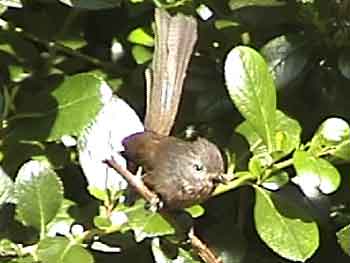Wrentit
Wrentit Video Clips

Wrentits are the only member of the Babbler Family (Timaliidae) living in our hemisphere. Their range extends south of the Columbia River in Oregon along the Pacific Coast to Northern Baja California. According to enature.com, "the Wrentit spends all of its adult life within the territory chosen in its first year. Individuals hesitate to cross open spaces of even 30 to 40 feet (9 to 12 meters), and it is believed that the wide Columbia River effectively stops the species from entering Washington, even though that side of the river offers a suitable habitat."
Wrentit Sound Clip
To listen to a sound file and view a waveform and spectrogram image of a Wrentit chattering click here.
Wrentits are very secretive and live in the dense, brushy thickets that surround our property. What gives them away is their "bouncing ball" song or their chatter. They are inquisitive. While weeding in the dense shrubbery, they stop by to investigate what is going on. They rarely come into plain view.
Wrentits Mate For Life
According to Audubon WatchList - Wrentit, "Wrentits are believed to mate for life. A pair will remain together in a suitable site, even as small as one acre. A bonded pair have been observed to snuggle up together at an overnight roost to the extent that they intertwine their legs, and intermesh their feathers; and, with their inner legs drawn up, they form a tight feathered ball (Erickson, M. M., 1948)."

Wrentit Wings
As you can see from the photo above, Wrentits have very small wings. These short wings are perfect for these very sedentary birds that rarely wander more than 1,300 feet from home. Once established, they have a one or two acre territory where they make their daily rounds of feeding on insects, bathing, raising a family and warding off intruders. Wrentits live about 12 years.
Wrentit Threats
Regarding threats to Wrentits, the Audubon WatchList - Wrentit says, "the local populations of Wrentits disappear or decline in numbers with increasing pressures from suburbanization. They have been observed using rural residential and agricultural areas. But since they nest close to the ground, feral cats, associated with housing developments are a growing threat to this species. Other concerns are overgrazing, off-road vehicles and fire. Most likely, however, it is habitat destruction that has led to its decline and current status on the Watchlist."
